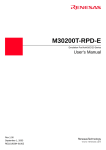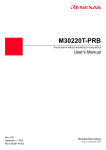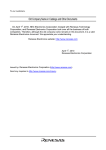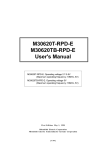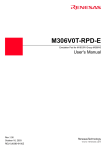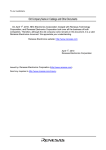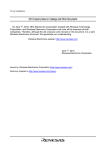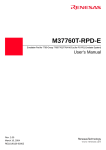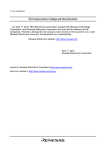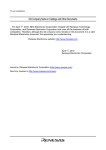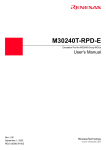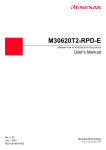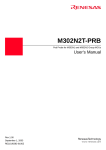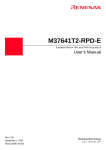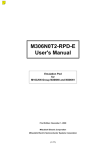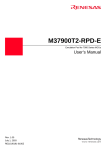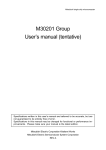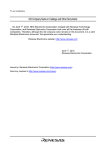Download M30201T-PRB User's Manual
Transcript
M30201T-PRB User's Manual Pod probe for M16C/20 Series First Edition: November 18, 1998 Mitsubishi Electric Corporation Mitsubishi Electric Semiconductor Systems Corporation ( 1 / 26 ) Microsoft, MS, MS-DOS, Windows and Windows NT are registered trademarks of Microsoft Corporation. IBM and PC/AT are registered trademarks of International Business Machines Corporation. IC83-5206-GG4 is a product of Yamaichi Electronics Co., Ltd. TQPACK and TQSOCKET are products of Tokyo Eletech Corporation. First Edition: November 18, 1998 Copyright © 1998 Mitsubishi Electric Corporation Copyright © 1998 Mitsubishi Electric Semiconductor Systems Corporation Precautions to Be Taken When Using This Manual • The information in this manual does not convey any guarantee or license for the use of the intellectual property rights or any other rights owned by Mitsubishi Electric Corporation, Mitsubishi Electric Semiconductor Systems Corporation, or third parties. • Mitsubishi Electric Corporation and Mitsubishi Electric Semiconductor Systems Corporation will not assume any responsibility for damage caused by or infringements on third parties' proprietary rights arising from the use of the product data, drawings, tables, or other materials in this manual. • The product data, drawings, tables, and all other materials in this manual reflect the latest information at the time of publication. However, Mitsubishi Electric Corporation and Mitsubishi Electric Semiconductor Systems Corporation reserve the right to make changes without notice for improvements on characteristics, etc. Please contact your nearest office of Mitsubishi or its distributor to get the latest information about the product described here before making your final decision to purchase, as necessary. • Mitsubishi semiconductors products are neither designed nor manufactured with any intention or whatsoever to cause hindrance to social systems or a threat to human life. When you plan to use the product described here in special applications such as transport or moving vehicles, medical, aerospace, or nuclear control, or submarine repeater equipment or systems, please consult your nearest office of Mitsubishi or its distributor. • This manual may not be copied, in whole or part, without the written consent of Mitsubishi Electric Corporation and Mitsubishi Electric Semiconductor Systems Corporation. • For inquiries about more information or questions and doubts about the contents of this manual, contact your nearest office of Mitsubishi or its distributor. Precautions to Be Taken When Using This Product • This product is a development support tool you can use in your program development and evaluation steps. When development of your program is completed, always be sure to verify its operation by board-based evaluation and test before putting it into mass production. • Mitsubishi will not assume any responsibility for the results arising from the use of the product. • Mitsubishi will respond to customer requests for the product, with expenses borne by Mitsubishi or the customer, as follows: (1) Repair or replacement of the product when it is found faulty (2) Modification of nonconformity when the product contains nonconformity. • This product has been developed by assuming its use for program development and evaluation in laboratories. Therefore, it does not fall under the application of electrical equipment control laws and protection against electromagnetic interference when used in Japan. • Do not attempt to modify this equipment. If modified, your authority to operate this equipment might be voided by FCC. Note: This equipment has been tested and found to comply with the limits for a Class A digital device, pursuant to part 15 of the FCC Rules. These limits are designed to provide reasonable protection against harmful interference when the equipment is operated in a commercial environment. This equipment generates, uses, and can radiate radio frequency energy and, if not installed and used in accordance with the instruction manual, may cause harmful interference to radio communications. Operation of this equipment in a residential area is likely to cause harmful interference in which case the user will be required to correct the interference at his own expense. Warning: This is a Class A product. In a domestic environment this product may cause radio interference in which case the user may be required to take adequate measures. Mitsubishi Tool Homepage http://www.tool-spt.mesc.co.jp/index_e.htm ( 2 / 26 ) Preface M30201T-PRB is a pod probe for M16C/20 Series of Mitsubishi 16-bit microcomputers. M30201TPRB is used by connecting to the M30200T-RPD-E emulation pod main unit and the PC4701 emulator main unit (PC4701HS, PC4701L, PC4700H or PC4700L), and is controlled by the emulator debugger. This manual mainly explains specifications and setting up of M30201T-PRB. For detail information about the emulation pod main unit, emulator main unit and emulator debugger, refer to each user's manual. To check the components of this product, refer to "Things to Check When Unpacking" in this manual. If there is any question or doubt about this product, contact your nearest Mitsubishi office or its distributor. To use the product properly Precautions for Safety: • Both in this User's Manual and on the product itself, several icons are used to insure proper handling of this product and also to prevent injuries to you or other persons, or damage to your properties. • The icons' graphic images and meanings are given in Chapter 1 Precautions for Safety. Be sure to read this chapter before using the product. ( 3 / 26 ) Contents Summary................................................................................................................................. 6 Terminology ........................................................................................................................... 7 Things to Check When Unpacking ......................................................................................... 8 Chapter 1. Precautions for Safety ........................................................................................... 9 1.1 Safety Symbols and Meanings .............................................................................. 9 WARNING Warning for Installation ................................................................................. 10 Warning for Use Environment ....................................................................... 10 CAUTION Caution to be Taken for Modifying This Product .......................................... 10 Cautions to be Taken for This Product .......................................................... 10 IMPORTANT Notes on PC4701 Emulator Main Units ........................................................ 11 Note on Abnormal Operation of PC4701 System ......................................... 11 Notes on the Target System ........................................................................... 11 Notes on Connecting Pod Probe and Pitch Converter Board ........................ 12 Note on Starting Up the Emulator System ..................................................... 12 Note on Reset Input from the Target System ................................................ 12 Note on Address 0 Access ............................................................................. 13 Note on Differences between Actual MCU and Emulator ............................ 13 Note on Referencing and Setting the Work Area .......................................... 13 Notes on MAP References and Settings ........................................................ 13 Notes on Changing Settings of the Memory Area ......................................... 13 Note on Stack ................................................................................................. 14 Note on BRK Instruction ............................................................................... 14 Note on Software Break and Hardware Break ............................................... 14 Notes on Using Address-match Interrupts ..................................................... 14 Note on Software Reset ................................................................................. 14 Note on Stop and Wait Modes ....................................................................... 14 Note on Watchdog Function .......................................................................... 14 Chapter 2. Introduction ......................................................................................................... 15 Chapter 3. Specifications ...................................................................................................... 16 Chapter 4. Setting Up ........................................................................................................... 17 4.1 Switch settings .................................................................................................... 17 Chapter 5. Connection .......................................................................................................... 18 5.1 Connection to the M30200T-RPD-E Emulation Pod Main Unit ........................ 18 5.2 Connection to the Pitch Converter Board ........................................................... 19 ( 4 / 26 ) Chapter 6. External Dimensions ........................................................................................... 21 Chapter 7. Maintenance and Warranty ................................................................................. 24 7.1 Maintenance ........................................................................................................ 24 7.2 Warranty .............................................................................................................. 24 7.3 Repair Provisions ................................................................................................ 24 7.4 How to Request for Repair .................................................................................. 25 Chapter 8. Troubleshooting .................................................................................................. 26 M30201T-PRB Repair Request Sheet Technical Support Communication Sheet ( 5 / 26 ) Summary Chapter 1. Precautions for Safety This chapter describes the precautions which should be taken in order to use M30201T-PRB safely and properly. Refer to each manual of the emulator main unit, emulation pod main unit and emulator debugger for their precautions. Chapter 2. Introduction This chapter provides the system configuration and overview of M30201T-PRB. Chapter 3. Specifications This chapter lists the product specifications of M30201T-PRB. Chapter 4. Setting Up This chapter describes how to set up the M30201T-PRB hardware according to your system. Chapter 5. Connection This chapter describes how to connect the M30201T-PRB, emulator main unit and target system. For connection between the host machine and emulator main unit and the installation of emulator debugger, refer to each user's manual of the products. Chapter 6. External Dimensions This chapter shows the external dimensions of M30201T-PRB and its pitch converter board. Chapter 7. Maintenance and Warranty This chapter describes maintenance and warranty of M30201T-PRB. Chapter 8. Troubleshooting This chapter describes what to do when the pod probe does not work properly. M30201T-PRB Repair Request Sheet Technical Support Communication Sheet ( 6 / 26 ) Terminology Some specific words used in this User's Manual are defined as follows: Emulator system This means an emulator system built around a PC4701 emulator. The PC4701 emulator system is configured with the emulator main unit, emulation pod main unit, pod probe, host machine, and emulator debugger. Emulator main unit PC4701 This means the generic name for the PC4701HS, PC4701L, PC4700H, and PC4700L emulators. Emulation pod main unit This means the emulation pod main unit M30200T-RPD-E for M16C/20 series. The emulation pod for M16C/20 series is comprised of the emulation pod main unit and this product. Pod probe This means an emulation pod probe (this product) for M30201 Group. Host machine This means a personal computer used to control the emulator and emulation pod. Emulator debugger This means a software tool to control the emulator from the host machine through an interface (serial, parallel or LAN). Emulator debugger: PD30 V.3.00 Host machine: IBM PC/AT or compatible OS: Windows 95 or Windows NT 4.0 CPU: 486DX4-100MHz or Pentium 75MHz (or faster recommended) Memory: 16MB or more Firmware This means a program that analyzes contents of communication with the emulator debugger and controls the emulator hardware. The emulator contains an EEPROM. You can download from the emulator debugger when upgrading the version of the firmware itself or when handling another MCU. Target MCU This means the microcomputer you are going to debug. Target system This means a user's application system using the microcomputer to be debugged. ( 7 / 26 ) Things to Check When Unpacking M30201T-PRB consists of the following parts and manuals. When unpacking, check to see if your M30201T-PRB package contains all of these items. Type name Description Quantity M30201T-PRB Pod probe for M30201 Group 1 M30201T-52SP Pitch converter board 1 M30201T-56FP Pitch converter board 1 Screws Screws for connecting the pod probe 2 M30201T-PRB English user's manual English user's manual (this manual) 1 M30201T-PRB Japanese user's manual Japanese user's manual 1 Please keep the M30201T-PRB’s packing box and cushion material in your place for reuse at a later time when sending your product for repair or other purposes. Always use these packing box and cushion material when transporting the products. If any of these items are missing or found faulty, please contact your distributor. Also, if there is any question or doubt about the packaged product, contact your distributor. Other tool products required for this product: • • • • • Emulator main unit: PC4701HS, PC4701L, PC4700H or PC4700L (essential) Emulation pod main unit (for M16C/20 Series): M30200T-RPD-E (essential) Emulator debugger: PD30 (essential) PROM programming adapter (for 56-pin LQFP package): PCA7302F1F-56 PROM programming adapter (for 52-pin SDIP package): PCA7302F1S-52 To purchase the products listed above, contact your nearest distributor. ( 8 / 26 ) Chapter 1. Precautions for Safety In both the M30201T-PRB User's Manual and on the product itself, several icons are used to insure proper handling of this product and also to prevent injuries to you or other persons, or damage to your properties. This chapter describes the precautions which should be taken in order to use M30201T-PRB safely and properly. Be sure to read this chapter before using this product. 1.1 Safety Symbols and Meanings WARNING If the requirements shown in the "WARNING" sentences are ignored, the equipment may cause serious personal injury or death. CAUTION If the requirements shown in the "CAUTION" sentences are ignored, the equipment may cause personal injury or damage to the products. IMPORTANT NOTE: Important information on using this product. In addition to the three above, the following are also used as appropriate. means WARNING or CAUTION Example: CAUTION AGAINST AN ELECTRIC SHOCK means PROHIBITION Example: DISASSEMBLY PROHIBITED means A FORCIBLE ACTION Example: UNPLUG THE POWER CABLE FROM THE RECEPTACLE. The following pages describes the symbols "WARNING", "CAUTION", and "IMPORTANT". ( 9 / 26 ) WARNING Warning for Installation: • Do not set this product in water or areas of high humidity. Make sure that the pod probe does not get wet. Spilling water or other liquids into the pod probe can cause an unrepairable damage. Warning for Use Environment: • This equipment is to be used in an environment with a maximum ambient temperature of 35°C. Care should be taken that this temperature is not exceeded. CAUTION Caution to be Taken for Modifying This Product: • Do not disassemble or modify this product. Disassembling or modifying this product can cause damage. Disassembling and modifying the product will void your warranty. Cautions to be Taken for This Product: • Use caution when handling the pod probe. Be careful not to apply a mechanical shock. • Do not touch directly the connector pins of the emulator main unit or the target MCU connector pins with your hand. • Do not pull the emulation pod main unit by the FLX120-RPD flexible cable or the FLX64 flexible cable. • The flexible cables FLX120-RPD and FLX64 are different from earlier models. The slits make them more flexible. However, excessive flexing or force may break conductors. • Do not use inch-size screws for this equipment. The screws used in this equipment are all ISO (meter-size) type screws. When replacing screws, use same type screws as used on the equipment. ( 10 / 26 ) IMPORTANT Notes on PC4701 Emulator Main Units: • When using this product outside Japan, be sure to use the PC4701HS or PC4701L emulator main unit. EMI standards are not met when this product is used with the PC4700H or PC4700L emulator main unit. • The PC4700H emulator main units whose serial number ends with a number cannot be used with M30201T-PRB. Use only products whose serial number ends with a letter of the alphabet. The serial number is on the bottom of the PC4700H. Example: 5KE100 .......... Can NOT be used with M30200T-RPD-E. Requires an upgrade. Example: 5LE123B ........ Can be used with M30200T-RPD-E. • Do not turn off the power when downloading firmware. If the emulator is powered off in the middle of the process, it will become unable to start up normally. In cases when the power is inadvertently shut off, re-execute downloading. Note on Abnormal Operation of PC4701 System: • If the PC4701 system does not pass all self-checks (excluding when an target system error occurs), there is the possibility of trouble in the system. In such case, contact the place of purchase. (Selfcheck should be executed when the target system is not connected.) • If the emulator main unit malfunctions due to external interference or some other causes, follow the steps given below. (1) Press the system reset switch located on the front panel of the emulator main unit. (2) If the emulator does not return to the normal operation despite the step (1) above, turn off the power source of the emulator, turn it on again. Notes on the Target System: • Because the emulation pod main unit does not have the capacity to supply power to other devices, design your system so that the emulator MCU is powered by the target system. • Make sure that the target's supply voltage is 2.7 to 5V. • Before turning on power to anything, check the host machine, emulator main unit, emulation pod main unit, pod probe, converter board and user's target system are properly connected. As explained here following, activate power to units as simultaneously as possible. Reverse the procedure to turn them off. (1) Turn on the target system. (2) Turn on the emulator main unit. ( 11 / 26 ) IMPORTANT Notes on Connecting Pod Probe and Pitch Converter Board: • When connecting the pod probe and the pitch converter board, be careful not to forcibly press the connector top of the converter board. (The flexible cable and the converter board are guaranteed for only 20 insertion/removal iterations.) • Especially be careful not to insert the converter board in the wrong direction. Note on Starting Up the Emulator System: • Check the emulator starts up properly from the target status LEDs on the front panel of the emulator main unit itself. When power is received from the target system: ... The POWER target status is ON. When the clock starts oscillating: ........................... The CLOCK target status is ON. When the reset is released: ..................................... The RESET target status is OFF. If the LEDs behave as described above within approximately 5 seconds (for PC4701HS and PC4700H) or 3 seconds (for PC4701L and PC4700L) of turning ON the power, the emulator has started up properly. Notes on Reset Input from the Target System: • The reset input from the target system is accepted only during program execution (while the RUN signal LED on the PC4701 is lit). ( 12 / 26 ) IMPORTANT Note on Address 0 Access: • With the M16C/20 series MCU, when a maskable interrupt is generated, the interrupt data (interrupt No. and interrupt request level) stored in address 0 is read out. Also, the interrupt request bit is cleared when address 0 is read out. Consequently, when the address 0 read-out instruction is executed or when address 0 is read out in the cause of a program runaway, a malfunction occurs in that the interrupt is not executed despite the interrupt request, because the request bit of the highest priority interrupt factor enabled is cleared. Note on Differences between Actual MCU and Emulator: • Emulator operation differs from mask MCU operation, as listed below: (1) Initial values of internal resource data at power-on (2) Internal ROM and RAM capacities, etc. (3) A/D converter A/D converter characteristics differ from actual MCU characteristics because the flexible cable and other elements are used between the emulation MCU and target system. Note on Referencing and Setting the Work Area: • The work area given below is assigned as the initial setting at the time of starting up the emulator debugger. Use the initial setting for the M30201T-PRB pod probe for M30201 Group. 02C0016 to 02C0F16: Work area Notes on MAP References and Settings: • When starting up M30200T-RPD-E, initial MAP settings are as follows. 0000016 to 003FF16: EXT 0040016 to FFFFF16: INT • Always set the SFR area to EXT (external). Note on Changing Settings of the Memory Area: • To debug an MCU different in memory capacity, be sure to modify the settings in the memory area before using the MCU. For memory maps of respective MCUs, see the MCU User's Manual. ( 13 / 26 ) IMPORTANT Note on Stack: • This product uses up to 8 bytes for stack. Note on BRK Instruction: • BRK instruction cannot be used. Note on Software Break and Hardware Break: • A software break and a hardware break cannot be used simultaneously. If they are used simultaneously, the emulation pod main unit may not work properly. Notes on Using Address-match Interrupts: • Do not set software breaks at the same addresses as address-match interrupts as the program may run out of control. • Do not set a hardware break within 4 instructions before an address at which an address-match interrupt occurs. If you do set a hardware break in this range, the program will run out of control. • When an address at which an address-match interrupt occurs is executed in one-step mode, the program stops after executing the first instruction after returning from the address-match interrupt processing. Note on Software Reset: • Do not use the software reset. It may not work properly. Note on Stop and Wait Modes: • Do not perform step execution at addresses in the stop or wait mode. It may cause communication errors. Note on Watchdog Function: • Debug functions such as a single step cannot be used while using the watchdog function. Only GO command (program execution) is possible. To use other debug functions, disable the watchdog function. ( 14 / 26 ) Chapter 2. Introduction M30201T-PRB is used by connecting to the PC4701 emulator and the M30200T-RPD-E emulation pod main unit. Figure 2.1 shows the system configuration. Figure 2.1 System configuration Products (1) to (3) shown in Figure 2.1 are included with this product. (1) M30201T-PRB (Pod probe) This pod probe is equipped with the M30201M4 evaluation MCU. (2) M30201T-52SP (Pitch converter board) This board connects the pod probe and the 52-pin SDIP socket on the target system. (3) M30201T-56FP (Pitch converter board) This board connects the pod probe and a foot pattern for 56-pin LQFP on the target system. ( 15 / 26 ) Chapter 3. Specifications Table 3.1 lists the specifications of M30201T-PRB. Table 3.1 Specifications of M30201T-PRB Usable emulator PC4701HS, PC4701L, PC4700H and PC4700L Emulation pod main unit M30200T-RPD-E Usable MCU M30201 Group MCUs Usable MCU mode Single-chip mode Emulation memory 1MB Clock 4.0 to 5.5V: Xin=10MHz 2.7 to 5.5V: Xin=7MHz (1 wait) Power supply range +2.7 to 5.5V Stack capacity used for emulator Up to 8 bytes Suspended cycles in run-time debug 16-byte dump: Approx. 312 BCLK cycle 16-byte fill: Approx. 283 BCLK cycle Power supply to emulation pod main unit 1. Supplied from an emulator main unit 2. The operating voltage of the emulation pod main unit is determined by detecting the supply voltage of the target system. When no target system is connected, or when the supply voltage of the target system is more than 5.0V, the operating voltage is 5.0V. Operating temperature range 5 to 35°C (no dew) Storage temperature range -10 to 60°C (no dew) ( 16 / 26 ) Chapter 4. Setting Up 4.1 Switch Settings Change the switch settings of FLX64-PRB for debugging according to target systems. Figure 4.1 shows the positions of the switches, and Table 4.1 shows the switch settings. Figure 4.1 Positions of the switches of FLX64-PRB Table 4.1 Switch settings of FLX64-PRB Function P71/Xcin P70/Xcout Switch setting Switch No. PORT PORT XCIN XCIN To use P71/Xcin as a port (Factory-setting) To use P71/Xcin as an Xcin PORT PORT NC NC To use P70/Xcout as a port (Factory-setting) Not to use P70/Xcout JP1 JP2 ( 17 / 26 ) Chapter 5. Connection 5.1 Connection to the M30200T-RPD-E Emulation Pod Main Unit The emulation pod for M30201 Group consists of the M30200T-RPD-E emulation pod main unit and the M30201T-PRB pod probe. Figure 5.1 shows how to connect the M30201T-PRB pod probe. And Figure 5.2 shows how to remove it. (1) Attach the J1 and J2 connectors of M30201T-PRB to the J3 and J4 connectors of FLX64-PRB respectively. (2) Secure the FLX64-PRB with the two screws. Figure 5.1 Connecting the M30201T-PRB pod probe (1) Unscrew the two screws of M30201T-PRB. (2) Lift off the M30201T-PRB from the FLX64-PRB. Pull the M30201T-PRB straight down carefully. Applying a twist to them may cause damage to the connectors. Figure 5.2 Removing the M30201T-PRB pod probe Caution Note on Connecting the Cable: • Be sure to turn off the power before making connections. Otherwise, the internal circuits may be damaged. • The small connectors (J3 and J4) of M30201T-PRB are guaranteed for only 20 insertion/removal iterations. • The small connectors (J3 and J4) of FLX64-PRB and the connectors (J1 and J2) of M30201T-PRB are guaranteed for only 50 insertion/removal iterations. ( 18 / 26 ) 5.2 Connection to the Pitch Converter Board Two pitch converter boards (M30201T-56FP and M30201T-52SP) are available for the emulation pod for M30201 Group. Figure 5.3 shows how to connect the M30201T-PRB to the M30201T-56FP for 56-pin LQFP. And Figure 5.4 shows how to connect the M30201T-PRB to the M30201T-52SP for 52-pin SDIP. (1) Mount the TQPACK056SB (included) on the target system. (2) Connect the TQSOCKET056SBP (included) to the TQPACK056SB. (3) Connect the M30201T-56FP to the TQSOCKET056SBP. (4) Connect the M30201T-PRB to the M30201T56FP. Figure 5.3 Connection to the M30201T-56FP pitch converter board for 56-pin LQFP ( 19 / 26 ) (1) Mount the IC83-5206-GG4 (made by Yamaichi Electronics Co., Ltd.) for 52-pin SDIP on the target board. (2) Connect the M30201T-52SP to the IC835206-GG4 mounted on the target board. (3) Connect the M30201T-PRB to the M30201T52SP. Figure 5.4 Connection to the M30201T-52SP pitch converter board for 52-pin SDIP Caution Note on Connecting the Cable: • Be sure to turn off the power before making connections. Otherwise, the internal circuits may be damaged. • The small connectors (J1 and J2) of M30201T-56FP are guaranteed for only 20 insertion/removal iterations. • The small connectors (J1 and J2) of M30201T-52SP are guaranteed for only 20 insertion/removal iterations. ( 20 / 26 ) Chapter 6. External Dimensions Figures 6.1 shows external dimensions of M30201T-PRB. Unit: mm Figure 6.1 External dimensions of M30201T-PRB ( 21 / 26 ) Figures 6.2 shows external dimensions and a sample foot pattern of the M30201T-56FP pitch converter board for 56-pin LQFP. And Table 6.1 shows the connector assignments of the M30201T56FP pitch converter board for 56-pin LQFP. Unit: mm Figure 6.2 External dimensions of M30201T-56FP Table 6.1 Connector assignments of M30201T-56FP ( 22 / 26 ) Figures 6.3 shows external dimensions of the M30201T-52SP pitch converter board for 52-pin SDIP. And Table 6.2 shows the connector assignments of the M30201T-52SP pitch converter board for 52pin SDIP. Use the IC83-5206-GG4 (made by Yamaichi Electronics Co., Ltd.) as a socket for the M30201T-52SP pitch converter board for 52-pin SDIP. Unit: mm Figure 6.3 External dimensions of M30201T-52SP Table 6.2 Connector assignments of M30201T-52SP ( 23 / 26 ) Chapter 7. Maintenance and Warranty 7.1 Maintenance If dust or dirt collects on any equipment of your emulator system, wipe it off with a dry soft cloth. Do not use thinner or other solvents because these chemicals can cause the equipment's surface coating to separate. 7.2 Warranty The emulation pod presented here has passed Mitsubishi's product inspection. If your emulation pod becomes faulty within 12 months after purchase while being used under good conditions by observing "Chapter 1. Precautions for Safety" in this manual, Mitsubishi will repair the fault free-ofcharge. (This provision does not apply to emulation pods leased to you.) When repair is required, contact your nearest of Mitsubishi office or its distributor. 7.3 Repair Provisions If a fault in your equipment falls under one of the following categories, the fault will be corrected by replacing the entire equipment instead of repairing, depending on the severity of fault: • Faulty or broken mechanical section • Flaw, separation, or rust in coated or plated section • Flaw or crack in plastic section • Fault or breakage caused by incorrect use or unauthorized repair or modification • Heavily damaged electric circuits due to shorting of power supply, overvoltage, or overcurrent • Crack in printed circuit board or burned-down patterns • Broad range of fault making replacement less expensive than repairing • Unlocatable or unidentifiable fault ( 24 / 26 ) 7.4 How to Request for Repair If your product is found faulty after checking items in "Chapter 8. Troubleshooting", follow the procedure below to send your product for repair. Customer Something found faulty Fill in the “M30201T-PRB Repair Request Sheet” attached hereto, then send it along with the M30201T-PRB for repair to your distributor or nearest office of Mitsubishi Electric. Make sure that information in the M30201T-PRB Repair Request Sheet is written in as much detail as possible to facilitate repair. Distributor Contents of fault checked After checking the contents of fault, the distributor should please send the faulty M30201T-PRB along with the Repair Request Sheet to Mitsubishi Electric. Mitsubishi Electric Semiconductor Systems Corporation, Repaired by When the faulty product is repaired, it will be returned to the customer at the earliest convenience. Caution Note on Transporting the Product: • When sending your product for repair, use the packing box and cushion material supplied with the product when delivered to you and specify handling caution for it to be handled as precision equipment. If packing of your product is not complete, it may be damaged during transportation. When you pack your product in a bag, make sure to use conductive polyvinyl supplied with the product (usually a blue bag). When you use other bags, they may cause a trouble on your product because of static electricity. ( 25 / 26 ) Chapter 8. Troubleshooting When the M30201T-PRB does not work properly, check the items listed below. (1) The emulator main unit cannot be powered up. Check to see if the AC power cord is firmly plugged into the receptacle. Check to see if the AC power 3P-2P converting connector is firmly connected. (2) Does not start up when the target system is connected with the PC4701 system. (The Error LED of the emulator main unit lights up.) Check (1) described above. Check whether the emulator main unit and the FLX120-RPD are firmly connected. Check whether the FLX120-RPD and the M30200T-RPD-E are firmly connected. Check whether the M30200T-RPD-E and the M30201T-PRB are firmly connected. Check whether the converter board (M30201T-56FP or M30201T-52SP) and the target system are firmly connected. Check whether the power and GND are supplied to the target system. Check whether switches of the M30201T-PRB pod probe are properly set. (see Chapter 5. Connection) Check whether the RESET pin is held 'HIGH' when the target system is connected. Check whether the oscillator circuit of the target system is oscillating correctly when using the oscillator of the target system. Check whether proper firmware is downloaded in the emulator main unit. (Refer to the user's manual of the emulator debugger about how to download firmware.) When the condition does not improve even if you check the items above, troubles described below are considered. (1) Trouble of the evaluation MCU (2) Trouble of the M30200T-RPD-E emulation pod (3) Trouble of the M30201T-PRB pod probe (4) Trouble of the PC4701 emulator main unit ( 26 / 26 ) M30201T-PRB Repair Request Sheet Date: / / ( Total Pages: ) To Distributor: Contact Address Product Information Product name: M30201T-PRB Serial number: Date of purchase: Target MCU: Frequency: MHz Voltage: V Company: Department: Responsible person: Phone: FAX: E-mail: Address: Symptoms: Occurrence frequency • Regularly • Frequency ( ) Write in detail by itemizing each observed symptom. Cause of fault: Write your estimated cause of fault or the sequence of operation when the fault occurred.. Operating environment: Emulator: LAN option [ Serial number: installed / not installed ] Serial number of PC4701LAN: Host machine: OS & version: Emulator debugger: Remarks: V V . . . . If you have any special request such as your desired delivery period, write it down here. If this form does not have sufficient space, use another sheet of paper to write your information. (1/ ) Technical Support Communication Sheet Date: / / ( Total Pages: ) To Distributor: Contact Address Product Information Emulator: Serial number: Emulation Pod: Serial number: Emulator debugger: Version: License ID: Host machine: OS & version : Target MCU: Company: Department: Responsible person: Phone: FAX: E-mail: Address: Message: If this form does not have sufficient space, use another sheet of paper to write your information. (1/ )





























